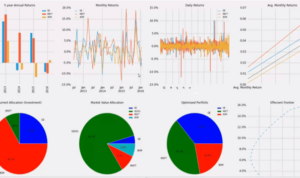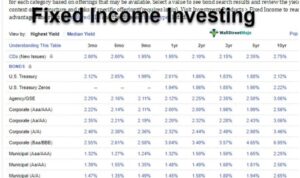As Stock market basics takes center stage, this opening passage beckons readers into a world crafted with good knowledge, ensuring a reading experience that is both absorbing and distinctly original. Get ready to dive into the fundamentals of the stock market and discover the key concepts that drive this dynamic financial landscape.
From understanding what stocks represent in a company to exploring investment strategies and the risks and rewards involved, this guide will equip you with the knowledge needed to navigate the exciting realm of stock trading.
Stock Market Overview
A stock market is a platform where buying, selling, and issuance of shares of publicly-held companies take place. It provides companies with access to capital and investors with ownership in the company.
Role of Investors in the Stock Market
Investors play a crucial role in the stock market by providing the necessary funds for companies to grow and expand their operations. They can buy and sell shares, influencing the price of stocks and the overall market trends.
Major Stock Exchanges Around the World
- The New York Stock Exchange (NYSE) – Located in the United States, it is one of the largest and most well-known stock exchanges in the world.
- NASDAQ – Also based in the United States, NASDAQ is known for its electronic trading platform and technology-focused companies listed on the exchange.
- London Stock Exchange (LSE) – Situated in the United Kingdom, the LSE is one of the oldest stock exchanges globally, with a diverse range of companies listed.
- Tokyo Stock Exchange (TSE) – As the largest stock exchange in Japan, TSE plays a significant role in the Asian financial markets.
- Shanghai Stock Exchange (SSE) – Located in China, SSE is one of the busiest stock exchanges in the world, reflecting the country’s economic growth.
Basics of Stocks
Stocks represent ownership in a company. When you buy a stock, you essentially own a small piece of that company, giving you the right to vote on certain company decisions and potentially receive dividends.
Difference between Common and Preferred Stocks
Preferred stocks typically offer fixed dividends, while common stocks have voting rights and the potential for higher returns through price appreciation. Preferred stockholders are paid dividends before common stockholders in the event of company profits.
How Stocks are Bought and Sold
- Stocks are bought and sold through stock exchanges like the New York Stock Exchange (NYSE) or the Nasdaq.
- Investors can place buy or sell orders through brokerage firms that execute the trades on their behalf.
- Stock prices fluctuate based on supply and demand in the market, impacted by factors like company performance, economic conditions, and investor sentiment.
- Stock transactions are settled typically within two business days after the trade date.
Stock Market Indices

Stock market indices are measures that represent a specific section of the stock market. They are used to track the performance of a group of stocks, providing insights into the overall market trends. Popular indices like the S&P 500, Dow Jones Industrial Average, and NASDAQ are widely followed by investors and analysts to gauge market performance.
S&P 500
The S&P 500 is a market-capitalization-weighted index that includes 500 of the largest publicly traded companies in the United States. It is considered a benchmark for the overall performance of the U.S. stock market.
- The index is calculated by taking the market capitalization of each company in the index and dividing it by the total market capitalization of all companies in the index, then multiplying by 100.
- Changes in the S&P 500 can reflect broader economic trends and investor sentiment.
- Investors use the S&P 500 as a gauge for the health of the U.S. economy and as a benchmark for their own portfolio performance.
Dow Jones Industrial Average
The Dow Jones Industrial Average, often referred to as the Dow, consists of 30 large-cap stocks representing various sectors of the U.S. economy. It is one of the oldest and most widely followed indices in the world.
- The index is price-weighted, meaning stocks with higher prices have a greater impact on the index’s movements.
- The Dow is used to assess the performance of blue-chip companies and is considered a barometer of the overall stock market.
- Changes in the Dow can influence investor sentiment and market direction.
NASDAQ
The NASDAQ Composite Index includes more than 2,500 stocks listed on the NASDAQ exchange, primarily technology and growth companies. It is known for its focus on the tech sector and is used to track the performance of technology stocks.
- The index is market-capitalization-weighted, with larger companies having a greater impact on its movements.
- NASDAQ is considered a benchmark for the technology sector and is used by investors interested in tech-related stocks.
- Changes in the NASDAQ can reflect trends in the technology industry and investor sentiment towards growth companies.
Investment Strategies
Investing in the stock market can be intimidating for beginners, but having a solid investment strategy can help navigate the ups and downs of the market. Here are some common investment strategies for beginners to consider:
Short-term Trading vs. Long-term Investing
Short-term trading involves buying and selling stocks within a short period, often based on technical analysis or market trends. It requires constant monitoring of the market and can be risky due to volatility. On the other hand, long-term investing focuses on buying and holding stocks for an extended period, typically years, to ride out market fluctuations and benefit from compound interest.
Diversified Stock Portfolio
Building a diversified stock portfolio is essential for reducing risk and maximizing returns. Diversification involves spreading your investments across different sectors, industries, and asset classes to avoid putting all your eggs in one basket. Here are some tips for building a diversified portfolio:
- Invest in different industries: Spread your investments across sectors like technology, healthcare, finance, and consumer goods to minimize sector-specific risks.
- Consider asset allocation: Allocate your investments across stocks, bonds, and other assets based on your risk tolerance and investment goals.
- Regularly rebalance: Periodically review your portfolio and rebalance it by selling overperforming assets and buying underperforming ones to maintain your desired asset allocation.
- Utilize index funds or ETFs: Consider investing in index funds or exchange-traded funds (ETFs) to gain exposure to a broad range of stocks and achieve instant diversification.
Risks and Rewards
Investing in the stock market comes with its fair share of risks and rewards. It is important for investors to understand these aspects before diving into the world of stocks.
Risks Associated with Investing
- Market Volatility: Stock prices can fluctuate rapidly, leading to potential losses for investors.
- Lack of Diversification: Putting all your money into one stock can be risky if that particular company underperforms.
- Company-Specific Risks: Factors like poor management decisions or legal issues can negatively impact a company’s stock price.
- Market Risks: Economic downturns, political instability, or global events can affect overall market performance.
Potential Rewards of Investing
- Capital Appreciation: Investing in stocks can provide the opportunity for your initial investment to grow over time.
- Dividend Income: Some companies pay out dividends to shareholders, providing a steady income stream.
- Ownership Stake: Buying stocks means owning a part of a company, giving you a say in its decisions and potential profits.
Examples of Successful and Unsuccessful Investments
- Successful: Investing in tech giants like Apple or Amazon early on has yielded significant returns for many investors.
- Unsuccessful: Putting all your money into a speculative penny stock that eventually went bankrupt can result in substantial losses.






